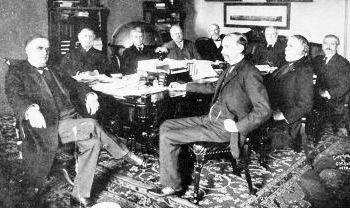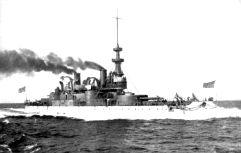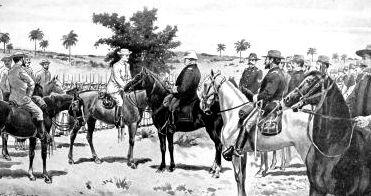|

McKinley War
Cabinet - Spanish-American War
|
Spanish-American War for kids: Background History
The acquisition of
island of Spanish owned Cuba, only ninety miles off the
shore from Florida, had long been a goal of
expansionists in the United States. The Spanish victory
over Cuba in the Ten Years War (1868–1878) foreshadowed
the Cuban rebellion that erupted between 1894-1898.
During the Cuban rebellion Spain sent over an army to
subdue the rebels and many Americans were highly
sympathetic to the Cuban cause.
Spanish-American War for kids: American Public Opinion
American public opinion was fuelled by anti-Spanish
propaganda led by journalists such as William Hearst and
Joseph Pulitzer who used sensationalist 'yellow
journalism' to emphasize the cause of the 'underdog'
against the system and criticize Spanish administration
of Cuba.
Spanish-American War for kids: President McKinley
Republican President
William McKinley, wished to prevent war, and hoping to settle the
Cuban question by peaceful diplomacy, proposed an armistice in Cuba.
However, a series of incidents during the first months of 1898
intensified American feelings against Spain, the most important
being the sinking of the U.S. battleship Maine. These events,
together with pressure applied by the public, the newspapers and the
Democrats led to the Spanish-American War. The United States first
sent the ultimatum to Spain demanding the Spanish surrender control
of Cuba. Madrid responded by declaring war on America and Washington
in turn declared war on Spain. The Spanish-American War began on
April 25, 1898. In less than four months it ended in victory for the
United States on August 12, 1898.
Causes of the
Spanish-American War
The causes of the Spanish-American War
were as follows:
Causes of the
Spanish-American War
Spanish-American War
Causes: Demands
by Cuban patriots for independence from Spanish rule
Spanish-American War
Causes: The
establishment of the 'reconcentrado' policy
(concentration camp system) by the Spanish in Cuba
Spanish-American War
Causes: American
investments in Cuba, especially shipping and the sugar
trade, suffered during the Cuban rebellion
Spanish-American War
Causes: William
Randolph Hearst's Publication of the stolen letter (de
Lôme letter), written by the Spanish minister in
Washington, which insulted the President
Spanish-American War
Causes:
Anti-Spanish Public opinion, fuelled by sensationalist
journalism
Spanish-American War
Causes: The
influence of the American policy of Expansionism and the
strong dislike of old Imperialism
Spanish-American War
for kids
The info about the Spanish-American War provides interesting facts and
important information about this important event that occured during the presidency of the 25th President of the United States of America.
Facts about the
Spanish-American War: Facts and Timeline for kids
Interesting Spanish-American War Facts and Timeline for kids are
detailed below. The history of the Spanish-American War is told in a
factual timeline sequence consisting of a series of interesting, short facts
providing a simple method of relating the
history of the Spanish-American
War for kids, schools and homework projects.
Spanish-American War Facts and Timeline for kids
Spanish-American War
Timeline Fact 1: 1868 -
Spanish victory over Cuba
in the Ten Years War (1868–1878)
Spanish-American War
Timeline Fact 2: April 10, 1892
- The Cuban Revolutionary Party, led by
José Martí, was officially proclaimed
Spanish-American War
Timeline Fact 3: 1894 - The Cuban War of Independence
(1894-1898) begins
Spanish-American War
Timeline Fact 4: 12 June, 1895
- President Cleveland issues a
proclamation of neutrality during the Cuban rebellion
Spanish-American War
Timeline Fact 5: 1896 - Spanish General Valeriano Weyler (the
"Butcher") arrives in Cuba and establishes the 'reconcentrado'
policy (concentration camp system)
Spanish-American War
Timeline Fact 6: 1896 - The rural population in Cuba was
forcibly confined to towns. Thousands of Cubans died
from disease and starvation
Spanish-American War
Timeline Fact 7: 26 Aug, 1896
- Grito de Balintawak begins the
Philippine Revolution
Spanish-American War
Timeline Fact 8: 1897 - General Weyler had relocated more
than 300,000 into the "reconcentration camps" Weyler
resigned his post in late 1897 and returned to Spain.
Spanish-American War
Timeline Fact 9: 19 Jan, 1897
- Anti-Spanish sentiment in the United
States is fuelled in the U.S. by Joseph Pulitzer's New
York World newspaper and William Randolph Hearst's New
York Journal
Spanish-American War
Timeline Fact 10: March, 1897
- Theodore Roosevelt was appointed
assistant U.S. Secretary of the Navy.
Spanish-American War
Timeline Fact 11: 1 Nov, 1897
- The revolutionary constitution in the
Philippines created the Biak-na-Bato Republic. Spain
makes concessions ending the revolution.
Spanish-American War
Timeline Fact 12: 1 Jan, 1898
- Spain grants limited autonomy to Cuba
Spanish-American War
Timeline Fact 13: January, 1898
- USS Maine sent to Cuba
Spanish-American War
Timeline Fact 14: Feb 8, 1898
- Enrique Dupuy de Lome, Spain's
ambassador to the U.S., resigns
Spanish-American War
Timeline Fact 15: Feb 9, 1898
- William Randolph Hearst publishes
Dupuy du Lome's letter insulting President McKinley.
Spanish-American War
Timeline Fact 16: 15 Feb, 1898
- U.S.S. Maine explodes and is sunk in
Havana Harbor, Cuba
Spanish-American War
Timeline Fact 17: 19 March, 1898
- The U.S.S. Oregon warship leaves the
port of San Francisco to Cuba.
● The U.S.S. Oregon was one of
the most renowned ships of the American Navy
● The battleship is famous for
the run from San Francisco around Cape Horn to take
part in the Battle of Santiago during which
Cervera's fleet was destroyed

U.S.S. Oregon
Spanish-American War
Timeline Fact 18: Feb 25, 1898
- Theodore Roosevelt cables Commodore
Dewey with a plan to attack the Philippines, if war with
Spain breaks out
Spanish-American War
Timeline Fact 19: 4 April, 1898
- Hearst's New York Journal issues a
million newspapers calling for the immediate U.S. entry
into war with Spain.
Spanish-American War
Timeline Fact 20: 20 April, 1898
- President McKinley issues an
ultimatum to Spain demanding Cuban independence
Spanish-American War
Timeline Fact 21: April 20, 1898
- The Teller Amendment is passed which
placed a condition on the United States military's
presence in Cuba whereby the U.S. could not annex Cuba
but only leave the "control of the island to its
people."
Spanish-American War
Timeline Fact 22: 23 April, 1898
- President McKinley calls for 125,000
volunteers
Spanish-American War
Timeline Fact 23: April 24, 1898
- Spain declares war on the US
Spanish-American War
Timeline Fact 24: April 25, 1898
- US declares war on Spain
Spanish-American War
Timeline Fact 25: May 1, 1898
- Battle of Manila Bay in the
Philippines. U.S. Commodore George Dewey in defeats the
Spanish fleet, under Admiral Patricio Montojo y Pasarón
Spanish-American War
Timeline Fact 26: May 10, 1898
- Secretary of the Navy, John D. Long,
issues orders to Captain Henry Glass, commander of the
cruiser U.S.S. Charleston to capture Guam on the way to
Manila.
Spanish-American War
Timeline Fact 27: 11 May, 1898
- Charles H. Allen succeeds Theodore
Roosevelt as assistant secretary of the navy
Spanish-American War
Timeline Fact 28: May 25, 1898
- First U.S. troops were sent to the
Philippine Islands
Spanish-American War
Timeline Fact 29: May 29, 1898
- The Rough Riders, the nickname of the
1st United States Volunteer Cavalry, sailed from Tampa,
Florida bound for Santiago de Cuba. The Rough Riders
were under the command of Colonel Leonard Wood and the
former assistant secretary of the United States Navy,
Theodore Roosevelt was second in command
Spanish-American War
Timeline Fact 30: 10 June, 1898
- U.S. Marines, under Admiral William
Thompson Sampson land at Guantanamo, Cuba.
Spanish-American War
Timeline Fact 31: 20 June, 1898
- Spanish authorities surrender Guam to
Captain Henry Glass on the U.S.S. Charleston
Spanish-American War
Timeline Fact 32: June 24, 1898
- US victory for the Rough Riders at
the Battle of Las Guasimas in Cuba
Spanish-American War
Timeline Fact 33: July 1, 1898
- The Battle of San Juan Hill, the most
famous battle of the War. The Rough Riders were led to
victory under the command of Theodore Roosevelt
Spanish-American War
Timeline Fact 34: July 3, 1898
- Battle of Santiago in which Spain's
Caribbean fleet was destroyed.
Spanish-American War
Timeline Fact 35: July 7, 1898
- The
Annexation of
Hawaii
Spanish-American War
Timeline Fact 36: July 17, 1898
- Spanish forces under General Toral
capitulated to U.S. forces at Santiago de Cuba. The City
of Santiago surrendered to General William Shafter. U.S.
General Leonard Wood was named military governor of
Santiago de Cuba.

Spanish-American War
Timeline Fact 37: July 30, 1898
- General Shafter instructed to return
troops immediately to the United States to prevent an
outbreak of yellow fever.
Spanish-American War
Timeline Fact 38: Aug 12, 1898
- Spain signs armistice (truce, peace
agreement) that ended all hostilities between Spain and
the United States in Cuba, Puerto Rico, and the
Philippines
Spanish-American War
Timeline Fact 39: Aug 13, 1898
- US troops capture Manila. General
Wesley Merritt established a military government in the
city
Spanish-American War
Timeline Fact 40: Dec 10, 1898
- The Treaty of Paris is signed and the
United States annexes Puerto Rico, Guam and the
Philippines. Spain renounces all rights to Cuba and
allows an independent Cuba. Spain also ceded Puerto Rico
and Guam to the United States, gave up its possessions
in the West Indies, and sold the Philippine Islands for
$20,000,000.
Spanish-American War
Timeline Fact 41 1 Jan, 1899
- Spanish forces left Cuba
Spanish-American War
Timeline Fact 42: Jan 23, 1899
- The Philippines declares itself an
independent republic, led by Emilio Aguinaldo. Emilio
Auginaldo was captured in March 1901
Spanish-American War
Timeline Fact 43: April 12, 1900
- The Foraker Act was passed in which
some elements of self-government was allowed in Puerto
Rico.
Spanish-American War
Timeline Fact 44: March 2, 1901
- The Platt Amendment outlined the role
of the U.S. in Cuba and the Caribbean. The
Cuban-American Treaty leased to United States the
southern portion of Guantanamo Bay, where a U.S. Naval
Station had been established in 1898
Spanish-American War
Timeline Fact 45: 1902 - US withdraws from Cuba
Spanish-American War Facts and Timeline for kids
Spanish-American War for kids - President William McKinley Video
The article on the Spanish-American
conflict provides detailed facts and a summary of one of the important events during his presidential term in office. The following
William McKinley video will
give you additional important facts and dates about the political events experienced by the 25th American President whose presidency spanned from March 4, 1897 to September 14, 1901.
Spanish-American War
●
Interesting Facts about Spanish-American War for kids and schools
●
Summary of the Spanish-American War in US history
●
Summary of the Spanish-American War
●
William McKinley from March 4, 1897 to September 14, 1901
●
Fast, fun facts about the Spanish-American War
●
Foreign & Domestic
policies of President William McKinley
●
William McKinley Presidency and
Spanish-American War for schools,
homework, kids and children |